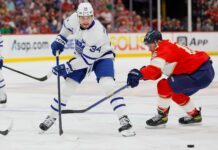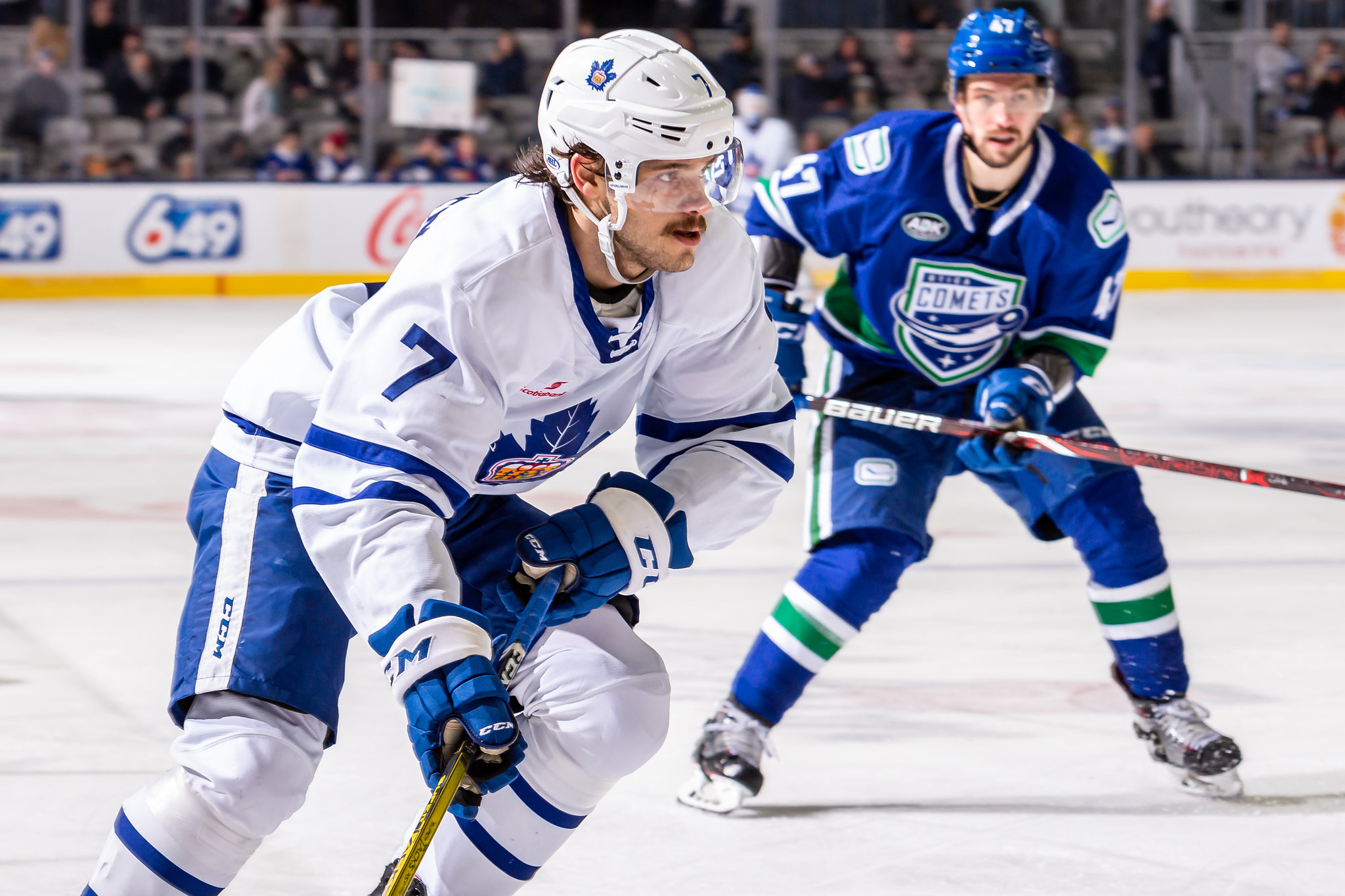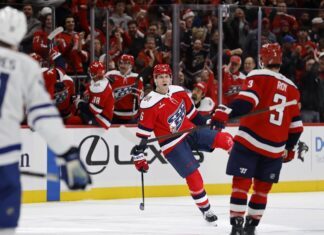The Toronto Marlies are currently three-quarters of the way through their eight-game road-trip while the Royal Boat Show takes up residence at the Coca-Cola Coliseum. Through 41 games, the Marlies have surpassed the midway point of their 76-game season. It’s time to take stock.
The question is where to start. It’s been as bizarre of a first half of a campaign as I can remember in my time covering this team.
Thanks to some high-powered offense, a dominant power play, and top-notch goaltending, Toronto came out of the gates flying. They reeled off six straight wins, picked up points in their first nine games, and remained unbeaten at Coca-Cola Coliseum until December 14.
A 4-1 victory against San Antonio on December 8 saw Toronto lead the North Division with a record of 17-4-3. Since then, it’s been a steep nosedive resulting in the Marlies sitting outside of a playoff spot at the time of writing with just one win four in their last 17 games (4-12-1).
There are certainly some extenuating circumstances with a high turnover in players (106 transactions in total, including some of the paper variety), injuries, and a coaching change behind the bench. The loss of players such as Pierre Engvall, Adam Brooks, Mason Marchment, Timothy Liljegren, Rasmus Sandin, and Pontus Aberg at different times of the season is never going to help, but the biggest upheaval was the promotion of the head coach on November 20.
Sheldon Keefe is almost synonymous with the Toronto Marlies. I’m sure if you asked the casual Maple Leafs fan who was the head coach of the Marlies before his tenure, they would struggle to remember. Never has a coach left his mark on a Toronto AHL affiliate like the Brampton native did — in the manner the team operated, the level of success (including a first Calder Cup championship) and player development, Keefe’s record is second to none.
In truth, this current Marlies team wasn’t playing to its full potential under Keefe leading up to his departure. The play of Kasimir Kaskisuo and rookie Joseph Woll was certainly helping to cover up many of the team’s deficiencies. There is no doubt in my mind that Keefe would have turned it around in time, but I have very little time for the excuses that have been bandied around since his departure.
Even with the three assistants left holding the reigns, performances failed to improve despite being able to dig out a few victories to begin with. When Greg Moore finally took charge of this team, they had lost three straight games and had been outscored 14-7 in the process, although they did rally from behind for their new head coach in a 7-3 win in Moore’s debut.
An 8-2 reverse to Syracuse might have been considered a blip at the time, but performances in defeats against Laval (1-6), Cleveland (1-4), San Antonio (3-4) and Charlotte (3-7) have left the impression that many players on the roster are simply going through the motions. When the fourth line comprised mostly of Rich Clune, Hudson Elynuik and Scott Pooley are impressing more on a game-to-game basis than the rest of the forward group, you know there are deep issues in need of immediate attention.
Slow starts, a lack of defensive responsibility, and an unwillingness to knuckle down and grind out performances when the chips are down are all worrying signs. Twice in the last three games, Toronto has trailed 4-0 by the midway mark of the game. Enough said.
This isn’t a roster bereft of talent despite the player movement up to the NHL. On a nightly basis, it should be able to give any team in the AHL a good run for its money.
“Lost for words right now. Pretty frustrated. I think the whole group is frustrated. I think we all haven’t been good enough. I think it’s going to take a group effort to climb our way out of this. Can we? Yes. Will we? Yes. Today’s another frustrating day. We’re going to find a way to right the ship.”
“There’s just an intensity that the game of hockey needs to have, for a team to have throughout the entire bench. We had it for the second period today. Again, the first period was not what we wanted in terms of talking about it and our slow start yesterday. But just a little bit more hard, a little bit more possession, a little bit more our style and doing the things that we preach here — we’re having a hard time finding that consistency.”
– Greg Moore after the Marlies‘ 7-3 loss to Charlotte on January 19
In past seasons, Toronto has been able to rely on veterans to help pull the team through when times got tough (think Colin Greening, Chris Mueller, Ben Smith, and Vincent LoVerde). However, this time, the experienced players have not been able to help right the ship and have been a part of the problem — to name a few, Tyler Gaudet, Matt Read, Nic Baptiste, Ben Harpur, and Jordan Schmaltz. The latter two have almost 150 NHL games between them, yet they have been consistently outplayed by rookie blueliners.
The power play has been the lone bright spot; it’s ranked fourth in the AHL at 22.6% and has been even better during the current road-trip, converting at 30%.
On the other side of special teams, the penalty kill has totally imploded, allowing at least one goal against in the last five games (eight in total), and it is now ranked 30th in the entire AHL (77.3%). It’s a blessing that the Marlies are one of the better-disciplined teams (averaging 3.75 times shorthanded per game), but at this moment in time, the PK does very little to inspire confidence and consistently sets back momentum in games.
The next five weeks will be crucial in determining whether the Marlies are going to be in contention for a playoff berth or if they’ll miss out on post-season hockey for the first time since 2011. Two road games against a desperate and hard-working Cleveland Monsters team will be followed by a pair at home against Charlotte, who recently humbled Toronto. It’s then 12 straight games (seven at home) against divisional rivals, with all teams in the North still in with a fighting chance at a playoff spot.
I am surprised there hasn’t been more player movement — whether through trades or reassignments from Newfoundland — but with the Toronto organization placing a huge amount of stock into their prospects playing hockey past April and developing a winning culture, changes are coming if performances and results don’t improve in the near future.
Player Grades
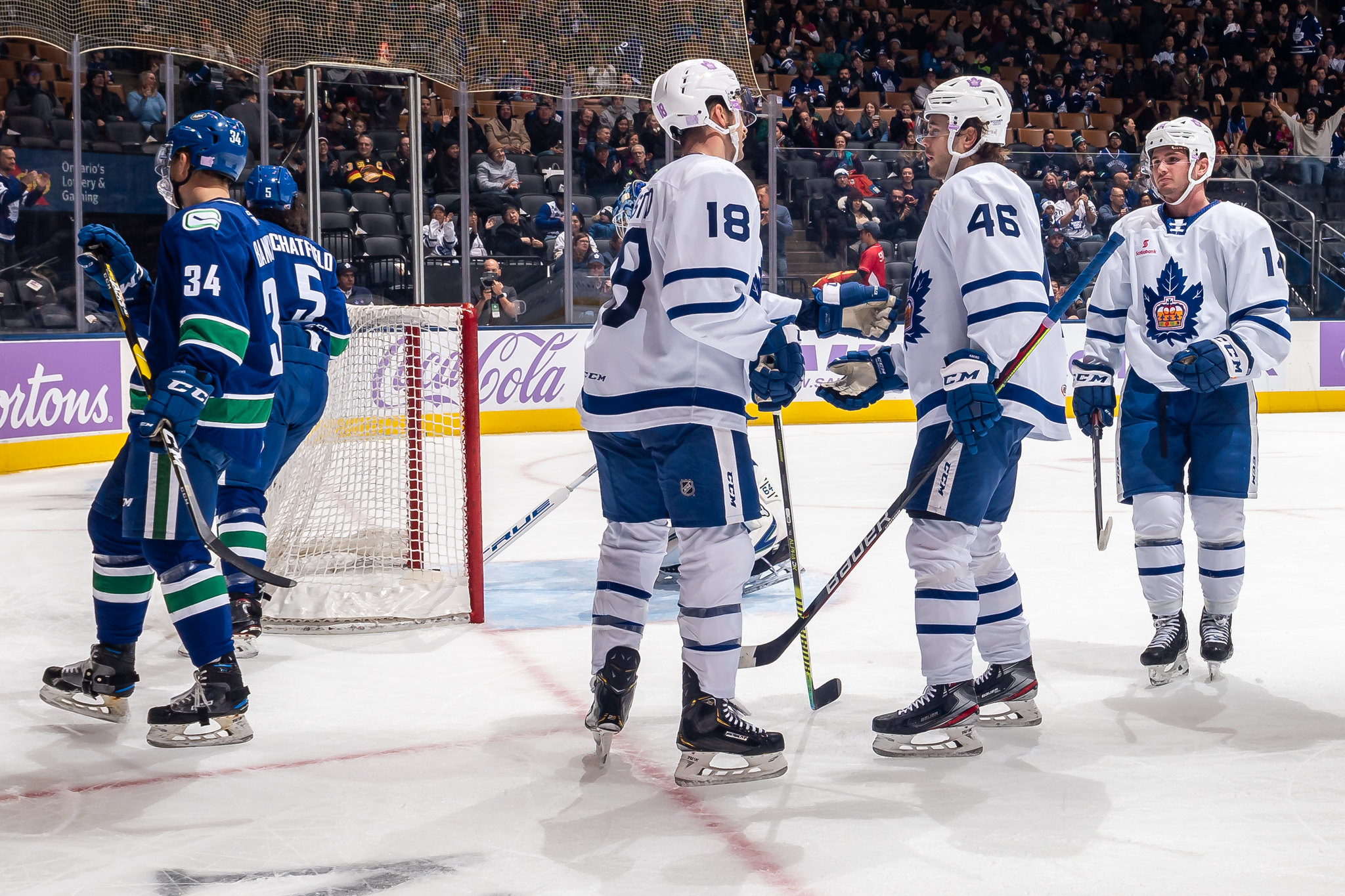
A
Kenny Agostino (34GP, 20g-13a-33pts)
“As advertised” would be the best way to describe Kenny Agostino. The noted AHL scorer leads the Marlies with 20 goals to his name, with 15 of those accrued at even strength. He also leads Toronto with 22 even-strength points, but I wonder how much his production might slow down in the second half as his current shooting percentage of almost 25% is likely unsustainable. The Marlies are going to rely on his scoring ability down the stretch.
Pontus Aberg (35GP, 14g-18a-32pts)
Aberg has consistently been a point-per-game producer in the AHL since 2016-17 and has been on that pace for most of the season until this current road-trip. He deserved his short-lived recall earlier in the season even if he wasn’t able to transfer his talent to the NHL on this occasion. Like Agostino, he’s come as advertised and brought the kind of offense that Toronto was seeking when they acquired him. He is only second behind his aforementioned teammate in even-strength production with 20 points.
Timothy Liljegren (33GP, 4g-20a-24pts)
Timothy Liljegren is ready for the NHL. There is no higher praise I could afford the young Swedish defenseman, whose trajectory this season has been nothing short of impressive. Somewhat overlooked because of his younger countryman, Liljegren has carried the Marlies’ blue line this season without any fanfare, playing top pair minutes, both special teams, and producing the numbers offensively that many doubted he could. He’s been the Marlies best defenseman on a nightly basis — and it’s not even close. Liljegren is ranked 12th in scoring amongst all AHL defenseman with 24 points despite fewer games played than his counterparts.
Nic Petan (15GP, 8g-13a-21pts)
The ultimate bubble player — and that’s not a knock against Nic Petan. I credit him for not being fazed by flipping between the two leagues. He has been ultra-impressive during his time with the Marlies, which speaks highly to his character. He has five multi-point hauls in 15 games, leads the team with six power-play goals, and is fifth in team scoring despite playing fewer than half the number of games as his teammates. If he stays in the AHL past the trade deadline, Petan will have a huge role to play in helping Toronto achieve a playoff berth.
Pierre Engvall (15GP, 7g-9a-16pts)
The best part about covering the Toronto Marlies and the AHL? Watching players like Pierre Engvall develop and then surprise the hell out of everyone when they arrive in the NHL. I’ll give credit to the writers at MLHS, who always had Engvall pegged as a future NHL’er. The Swedish forward certainly left a giraffe size hole behind him on the Marlies; he played top six, both special teams, and he was relied on heavily in key situations. If you need further proof, Engvall recorded at least a point in all situations, including an empty-net goal. In the little I saw of him with the Marlies this year, he looked too good for the AHL. I’m delighted that he’s now receiving his well-earned opportunity in the show.
Adam Brooks (20GP, 8g-8a-16pts)
I debated whether Brooks should be given an A-, but I’ll stick with this grade just because he’s shown great resilience once again following another injury. He’s had to take up some of the slack left by the departed Engvall, and he has responded well for the most part. His recall to the NHL left the Marlies somewhat thin down the middle, with his absence more hard-felt than in previous years when he was unavailable. 11 of his 16 points are primary markers. If he stays healthy, he’s set for a career year in all point categories. Brooks is another player who has to carry the load if the Marlies are to bounce back. There is extra motivation for the 23-year-old as he finishes this season as an RFA.
A-
Teemu Kivihalme (35GP, 3g-7a-10pts)
Before this current road-trip, I might have given the Finnish defenseman an A grade, but he’s really struggled in the last few games. That being said, I was very impressed with him beforehand, so I’m not going to let a few poor performances slide him down the rankings too far. He’s been extremely poised in possession and has been one of the better Toronto blueliners in leading breakouts this season (admittedly not a high bar with Schmaltz and Harpur on the team). I was surprised when checking my statistics that he had only accrued 10 points this season as he’s been very creative offensively and is not afraid to join the rush or pinch in when required. After bouncing around a few pairings before recently taking on top pair minutes alongside more inexperienced defensemen, it’s not been an easy introduction to the AHL. Kivihlme has flourished for the most part.
Kasimir Kaskisuo (20GP, 11-5-2, .911SV%, 2.67GAA, 1 SO)
The Finnish goaltender has carried on his form from the second half of last season and has been a huge component of any success Toronto has had to date. It’s simply unfair to judge Marlies goaltending on the numbers this season as the performances in front of them have been unpredictable at best, with far too many defensive zone turnovers and missed assignments, among other issues, leading to grade-A scoring opportunities for the opposition.
Rasmus Sandin (21GP, 2a-13a-15pts)
Why hasn’t Rasmus Sandin been graded an A?! The simple reason is that the young Swedish blue line still requires to do some work in his game defensively along with improving his decision making, which I’m sure will come with experience. With that in mind, I would not be surprised to see him finish the season back in the AHL, where he would once again be afforded top-pairing, all-situations minutes to further his development. It’s rare to see a young player with so much confidence as a defenseman, and that has allowed Sandin to have so much success offensively. Just under half of his offensive production is primary markers, but playing on the first power-play unit, Sandin has put up seven points (1-1-5) to date.
B+
Joseph Woll (19GP, 7-10-2 .890SV%, 3.60GAA, 1SO)
Woll has been thrown to the wolves far too often in his rookie year. In net for blowout losses inflicted by Laval, Syracuse, and most recently Charlotte, I would not be surprised if his confidence is beginning to take a hit despite his seemingly unflappable nature and calm persona. The faltering penalty kill certainly isn’t helping matters. Woll’s numbers look horrific from the outside, but they do no justice to his level of play, which I believe warrants this grade.
Kalle Kossila (12GP, 3g-3a-6pts)
I had high hopes for Kossila, but like Marchment, an injury has set him back. There’s no doubting his offensive qualities in the AHL, but he’s only now finding his feet with 12 games under his belt. Six points in those games isn’t a bad return (five at ES and all primary markers), but the Marlies are hoping he’ll be found money in the second half of the year if he reproduces the type of output he managed in previous seasons for the San Diego Gulls.
Scott Pooley (14GP, 4g-0a-4pts)
I have a lot of time for Scott Pooley, and I’m pleased he’s getting a decent look at the AHL level. He has been limited to a fourth-line role for all but one game, so four goals in 14 games is a tidy return for the number of minutes he’s received. The rookie has earned enough trust from the coaching staff to be used on both special teams in recent games. He has a nice combination of speed and strength and he isn’t afraid to use his sizeable frame.
I would like to see what he could achieve on a forward line with more offensively-talented linemates, but either way, he’s earned his place on the team for the second half of the season by performing consistently well to date.
Kristians Rubins (28GP, 1g-6a-7pts)
Rubins’ biggest issue will probably be his skating ability throughout his career, but he’s made some giant strides (pun intended) and has proven himself one of the more reliable blueliners in his rookie season. His gap control still requires a little work, but he uses his huge frame and long stick effectively to close out opponents. Somewhat surprisingly, he’s also shown some offensive flair and certainly surprised one or two teams with what he’s capable of in the o-zone, although I would like to see him shoot a little more often as he does own a deceptive wrist shot and a heavy slapshot.
B
Mason Marchment (14GP, 5g-4a-9ts)
Marchment is a difficult player to assess as he had to wait until December to begin his season following an injury sustained in training camp. After showing a lack of discipline a little too often for my liking during the first few games back in the AHL, the towering winger knuckled down and earned himself a first taste of the NHL. The task at hand for Marchment is consistency. In a recent outing against Charlotte, he scored a hat-trick (including a short-handed goal), he was physical without going over the line (he really got under the Checkers’ skin), and he recorded eight shots on goal as he almost won the game single-handedly for Toronto. More of that dominance, please, in the second half of the season.
Rich Clune (13GP, 3g-1a-4pts)
Rich Clune doesn’t tend to play much these days, but he has been leaned on a little in recent weeks and hasn’t let the team down. Providing energy from the fourth line role, he’s enjoyed playing alongside a pair of young linemates in Elynuik and Pooley, which has led to the veteran providing some offense. It’ll be interesting to see how much more playing time Clune is handed in the second half of the year depending on how things pan out.
Jesper Lindgren (29GP, 1g-8a-9pts)
I’m left wanting for Lindgren to show me more, but I often forget he’s a rookie. Defensively, he’s improved from when we first saw him, he skates well, and he is fine on breakouts, although doesn’t seem to have the same confidence to lead the rush as either Liljegren or Sandin. Despite the team imploding around him of late, Lindgren has been one of its better performers when afforded more responsibility, and I look forward to seeing what he has in the locker for the second half. Time is one his side with a year left on his contract.
Egor Korshkov (27GP, 9g-7a-16pts)
A leg laceration has led to the Russian forward missing a chunk of time. He remains out with that injury after a comeback proved short-lived. He’s not the player I thought he was, but that isn’t necessarily a bad thing. Korshkov hasn’t driven hard to the net often and appears to lack high-end skating ability. However, he does protect the puck really well in battles along the boards, is a better passer than you might imagine, and he is adept as net presence. He’s scored on both special teams as well as at even strength despite not owning the best shot, but we are left wondering just what his upside really is due to a lack of playing time.
Jeremy Bracco (40GP, 3g-29a-32pts)
Probably the hardest player to assess on the current roster and my greatest source of frustration this year (I nearly gave him a B-), Bracco continues to be an excellent passer of the puck and one of the best in the organization in that facet of the game. Given time or space, Bracco is capable of hurting opponents, but when closed down, limited space and physicality comes into play and the right-winger becomes a non-factor.
Since the rumours of a trade request, there’s no doubt Bracco has appeared less engaged overall. He has been unwilling to consistently back check and accept defensive responsibility with the consistency needed. Without a goal in 16 games, Bracco is averaging one shot per game during that time and has become too predictable for defenders and goaltenders alike. At a time when the Marlies need their best players to be their best players, Bracco has only shown up sporadically, and that just isn’t going to cut it in his drive to make the next step. It’s a huge second half of the season for Bracco in terms of his future career as he’s an RFA this summer.
Garrett Wilson (34GP, 7g-4a-11pts)
Wilson has been deployed in a variety of roles this season, including both wings, which is why his production is down from his time in Wikes/Barre Scranton (0.62PPG). One of the team’s more consistent veteran forwards, Wilson should be granted a larger role further up the line-up, in my opinion, during the remainder of the season.
B-
Hudson Elynuik (34GP, 2g-5a-7pts)
I don’t feel as though Hudson Elynuik has performed badly this season, but he’s another player I’m left wanting more from. Relatively reliable and defensively sound, it’s in the offensive end that I’d like to see a little more bite from a player who should be causing opponents more headaches with his physical attributes. Too prone to playing on the perimeter, I would really like to see the towering Elynuik drive toward the net more often and create carnage around the slot area.
Mac Hollowell (13GP, 0g-2a-2pts)
The Mac Hollowell of last season’s playoff run was full of confidence and not afraid to make adventurous plays, most of which led to good things. He needs to turn that switch back on as he’s now playing tentatively and is almost second-guessing himself in every aspect of his game, which is proving costly in the defensive zone. It’ll be interesting to see whether Toronto decides to persevere with him in the AHL if and when bodies return to the roster.
Tanner MacMaster (36GP, 8g-9a-17pts)
I’ll hold my hands up and say I didn’t think Tanner MacMaster should be in the AHL when the season began after he failed to impress in the previous campaign. He proceeded to make a fool out of me during a nine-game point streak, but he has since reverted to type, putting up three points in his last 16 games, proving himself a defensive liability, and turning the puck over at will. Personally, I would much rather see one of the prospects in Newfoundland given an opportunity over MacMaster in the second half of the season as the former Utica forward has had more than a fair shake to prove his worth with the Marlies.
Darren Archibald (27GP, 7g-4a-11pts)
Archibald is a player noted for his physical style and snarl, but that has largely been absent during his short tenure with the Marlies, although his offensive output is slightly better than I would have predicted.
C
Tyler Gaudet (37GP, 2g-11a-13pts)
Perhaps my expectations were too high for Tyler Gaudet heading into this season, but I’ve been left very underwhelmed by his level of performance and production. He entered this season with almost 300 AHL games under his belt and would have been expected to step up when the chips were down, but that simply hasn’t been the case. He has just three points in his last 15 games and has too often been largely ineffective in a third-line role.
Matt Read (29GP, 5g-7a-12pts)
Unable to secure himself an NHL deal on a PTO in training camp, Read opted to sign an AHL deal with the Marlies, but his performances have been a disappointment overall. He’s found some offense of late with seven points in the last 11 outings, and the hope is this is a platform for something better down the stretch.
Nicholas Baptiste (24GP, 3g-5a-8pts)
Baptiste has flattered to deceive during his time in Toronto with the odd standout performance followed by a series of mediocre outings. I would not be surprised if he were traded should the Marlies opt to shake up their roster.
Ben Harpur (28GP, 0g-8a-8pts)
It’s a mystery to me how any team considered Harpur capable of playing in the NHL. He’s been nothing short of a defensive liability in the AHL — continually beaten on the outside by speedier forwards — and his decision making is questionable at best. It’s painful to watch him attempt to lead the breakout and opponents are aware of his limitations in that regard.
Jordan Schmaltz (29GP, 2g-9a-11pts)
I could copy and paste what I wrote about Ben Harpur into this section. When the two were paired together for a couple of the games, the result was as bad as you might expect.
11 points isn’t a terrible return offensively, but he’s struggling to do even the basics on breakouts out of his own zone and he has been a liability in the same mould as Harpur.
Ungraded (Played fewer than ten games)
- Kevin Gravel (8GP 0g-0a-0pts)
- Joseph Duszak (8GP 1g-1a-2pts)
- Zach O’Brien (5GP 1g-1a-2pts)
- Martin Marincin (5GP 0g-1a-1pts)
- Giovanni Fiore (4GP 1g-0a-1pts)
- Aaron Luchuk (3GP 0g-0a-0pts)
- Michael Kapla (3GP 0g-1a-1pts)
- Matt Bradley (2GP 0g-0a-0pts)
- Giorgio Estephan (2GP 0g-0a-0pts)
- Justin Brazeau (1GP 0g-0a-0pts)
- Brady Ferguson (1GP 0g-0a-0pts)
- Colt Conrad (1GP 0g-1a-1pts)
- Trevor Moore (1GP 0g-1a-1pts)


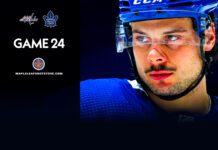


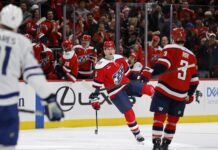



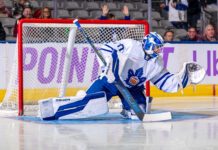

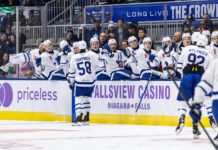
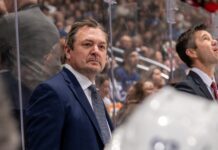


![John Gruden after the Leafs prospects’ 4-1 win over Montreal: “[Vyacheslav Peksa] looked really comfortable in the net… We wouldn’t have won without him” John Gruden, head coach of the Toronto Marlies](https://mapleleafshotstove.com/wp-content/uploads/2025/09/gruden-post-game-sep-14-218x150.jpg)







